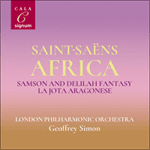Saint-Saëns’s final work involving the cello was
La muse et le poète, Op 132, in which that instrument is joined by a violin to form what he referred to as a conversation between the two instruments instead of a debate between two virtuosos. The background to the work’s composition has its bizarre side. A statue of the composer had been exhibited in the Paris Salon of 1907. A female admirer, Mme Caruette, wanted to present it to the town of Dieppe, but strictly a law forbade the erection of statues to the living. However, political intervention solved that problem and the statue duly found a place in the town’s theatre, allowing Saint-Saëns to make one of his tart sallies, to the effect that since he must be dead to have a statue of himself put up, he wouldn’t need to make a speech. When the good Mme Caruette rejoined her ancestors in 1909, he wrote a one-movement piano trio in her memory which his publisher, Jacques Durand, insisted on giving the title it now bears, much to his fury. He then orchestrated it and the work was premiered in London in 1910 by Ysaÿe and Hollman. A critic of the Parisian premiere found in it tenderness, sombreness and pain as well as an inner drama. Beyond these qualities, listeners need not make an effort to discern a form for the piece: its improvisational structure was deliberate, as a hit against the Germans whose insistence on formal rigour was, he felt, destroying music’s soul.
from notes by Roger Nichols © 2014
La dernière œuvre de Saint-Saëns qui fait appel au violoncelle est
La muse et le poète, op.132, où cet instrument est associé à un violon pour former ce qu’il appelait une conversation entre les deux instruments au lieu d’une discussion entre deux virtuoses. Le contexte de la composition de cette œuvre a quelque chose de bizarre. Une statue du compositeur avait été exposée au Salon de Paris de 1907. Une admiratrice, Mme Caruette, voulait la présenter à la ville de Dieppe, mais une loi interdisait strictement d’ériger des statues aux personnes vivantes. Toutefois, une intervention politique résolut ce problème et la statue trouva une place comme prévu dans le théâtre de la ville, ce qui permit à Saint-Saëns de faire l’un de ses traits d’esprit acerbes: puisqu’il devait être mort pour que sa propre statue soit érigée, il n’avait pas besoin de faire de discours. Lorsque la bonne Mme Caruette rejoignit ses ancêtres en 1909, il écrivit un trio avec piano en un mouvement à sa mémoire; et son éditeur, Jacques Durand, insista pour qu’il porte son titre actuel, ce qui mit le compositeur dans une colère folle. Il l’orchestra ensuite et l’œuvre fut créée à Londres en 1910 par Ysaÿe et Hollman. Un critique de la première exécution parisienne y trouva de la tendresse, un côté sombre et de la douleur ainsi qu’un drame intime. Au-delà de ces qualités, les auditeurs n’ont pas besoin de chercher à trouver une forme à cette pièce: sa structure proche de l’improvisation était délibérée, comme un coup contre les Allemands dont l’insistance sur la rigueur formelle était, à son avis, en train de détruire l’âme de la musique.
extrait des notes rédigées par Roger Nichols © 2014
Français: Marie-Stella Pâris
Saint-Saëns’ letztes Werk mit Solocello war
La muse et le poète, op. 132, wo an die Seite des Cellos eine Geige tritt und sich, wie er sich ausdrückte, ein Gespräch zwischen den beiden Instrumenten anstelle einer Diskussion zwischen den beiden Virtuosen entspinnt. Der Entstehungshintergrund dieses Werks hat eine bizarre Seite. 1907 war im Pariser Salon eine Statue von Saint-Saëns ausgestellt worden. Eine Verehrerin des Komponisten, Mme Caruette, wollte diese Statue in der Stadt Dieppe aufstellen lassen, doch existierte ein Gesetz, wonach die Errichtung von Statuen lebender Menschen ausdrücklich verboten war. Durch politisches Eingreifen wurde dieses Problem jedoch gelöst und die Statue wurde im städtischen Theater untergebracht, was Saint-Saëns zu einem seiner scharfzüngigen Kommentare veranlasste, nämlich dass er, wenn eine Statue von ihm errichtet worden sei, tot sein und daher keine Rede halten müsse. Als die gute Mme Caruette sich 1909 zu ihren Vorfahren gesellte, schrieb er ein einsätziges Klaviertrio zu ihrem Andenken, dem sein Verleger Jacques Durand, sehr zum Ärger des Komponisten, den Titel verlieh, den es noch heute trägt. Saint-Saëns richtete das Werk für Orchester ein und es wurde 1910 in London von Ysaÿe und Hollman uraufgeführt. Ein Kritiker, der die Pariser Premiere gehört hatte, fand in dem Werk Sanftheit, Düsterkeit, Schmerz sowie innere Dramatik. Darüber hinaus braucht man sich als Hörer nicht darum zu bemühen, eine Form herauszuhören—die improvisatorische Struktur war beabsichtigt und als Angriff gegen die Deutschen gedacht, deren Beharren auf formaler Strenge seiner Meinung nach die Seele der Musik zerstöre.
aus dem Begleittext von Roger Nichols © 2014
Deutsch: Viola Scheffel


 PERFORMANCE
PERFORMANCE RECORDING
RECORDING
 Saint-Saëns: Africa & other orchestral works
Saint-Saëns: Africa & other orchestral works
